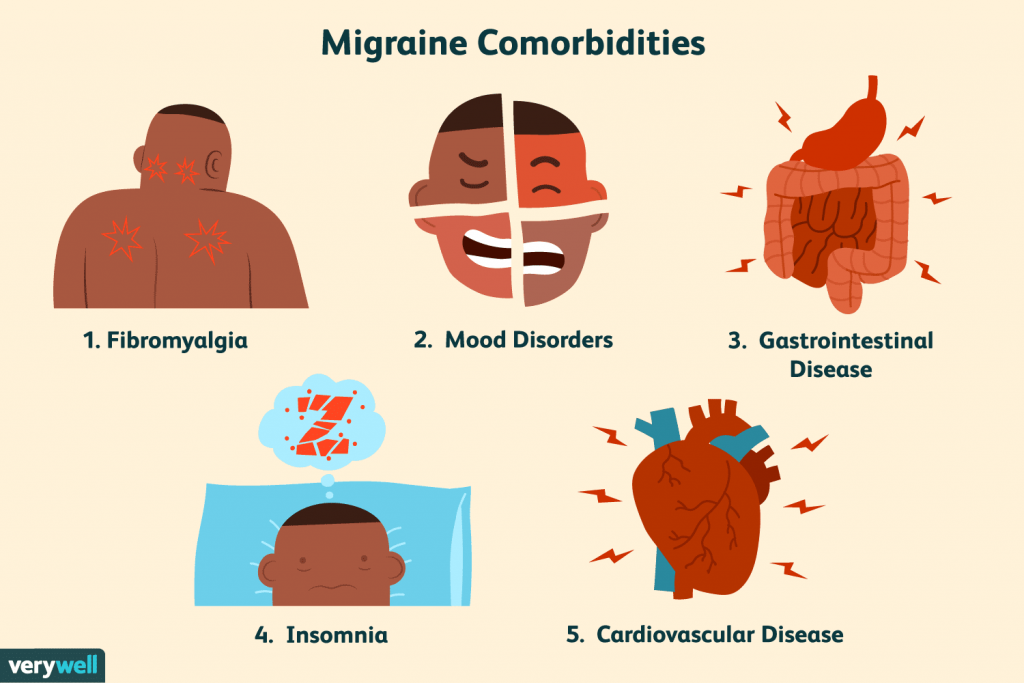
Migraine
What are migraines?
Migraines are severe throbbing, pulsating recurring type of headaches, and usually on just one side of the head. It’s often accompanied by nausea, vomiting, and extreme sensitivity to light and sound. Migraine attacks can cause significant pain for hours to days and can be so severe that the pain is disabling.
What causes migraines?
Researchers believe that migraine has a genetic cause. There are also a number of factors that can trigger a migraine, including stress, anxiety, hormonal changes in women, bright or flashing lights, loud noises, strong smells, medicines, too much or not enough sleep, sudden changes in weather or environment, overexertion (too much physical activity), tobacco, caffeine or caffeine withdrawal, skipped meals, medication overuse (taking medicine for migraines too often), certain foods and food additives.
Who is at risk for migraines?
Migraines can affect anyone, but you are more likely to have them if you:
- Are a woman. Women are three times more likely than men to get migraines.
- Have a family history of migraines. Most people with migraines have family members who have migraines.
- Have other medical conditions, such as depression, anxiety, bipolar disorder, sleep disorders, and epilepsy.
What are the symptoms of migraines?
There are four different phases of migraines. You may not always go through every phase each time you have a migraine.
- Prodome. This phase starts up to 24 hours before you get the migraine. You have early signs and symptoms, such as food cravings, unexplained mood changes, uncontrollable yawning, fluid retention, and increased urination.
- Aura. If you have this phase, you might see flashing or bright lights or zig-zag lines. You may have muscle weakness or feel like you are being touched or grabbed. An aura can happen just before or during a migraine.
- Headache. A migraine usually starts gradually and then becomes more severe. It typically causes throbbing or pulsing pain, which is often on one side of your head. But sometimes you can have a migraine without a headache. Other migraine symptoms may include
- Increased sensitivity to light, noise, and odors
- Nausea and vomiting
- Worsened pain when you move, cough, or sneeze
- Postdrome (following the headache). You may feel exhausted, weak, and confused after a migraine. This can last up to a day.
Migraines are more common in the morning; people often wake up with them. Some people have migraines at predictable times, such as before menstruation or on weekends following a stressful week of work.
How are migraines diagnosed?
There’s no specific test to diagnose migraines. For an accurate diagnosis to be made, your Doctor must identify a pattern of recurring headaches along with the associated symptoms.
Doctor may ask if your headaches are:
- On one side of the head
- A pulsating pain
- Severe enough to prevent you carrying out daily activities
- Made worse by physical activity or moving about
- Accompanied by nausea and vomiting
- Accompanied by sensitivity to light and noise
An important part of diagnosing migraines is to rule out other medical conditions which could be causing the symptoms. So you may also have blood tests, an MRI or CT scan, or other tests.
HOMEOPATHIC TREATMENT-
Homeopathic medicines provide symptomatic relief in Migraines. The medicines are selected basis the theory of individualization and symptoms similarity by using Homoeopathic holistic approach.
Following remedies are highly effective in the treatment of migraine:
- Belladonna
- Intense headache with violent throbbing pains, extreme sensitivity to light, noise, touch.
- Pains begin and end suddenly, most often focused in forehead.
- Pain may extend from forehead to back of head, face flushed and hot, hands and feet may be cold.
- Bryonia
- Patient has a heavy or “splitting” headache, pain settles over one eye (especially the left).
- Pain is worse from any motion, even from moving the eyes.
- Nausea with a heavy feeling in the stomach and vomiting may occur.
- Gelsemium
- Pain begins at back of head and extends to rest of head or forehead.
- Feels like a band is bound tightly around head.
- Pain localized on right side of head, worse by light, noise, and motion.
- Better from napping or urinating.
- Nux vomica
- Headaches brought on by overeating, use of alcohol, coffee or other drugs, or missed sleep.
- Pain from mental over-exertion, cold air or cold wind.
- Worse in morning, especially on first waking.
- Glonoinum
- This remedy relieves sudden headaches, with fullness of head.
- Feeling of heat, and aggravated by heat.
